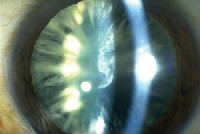The increasing hole in the ozone layer will likely increase the number of cataracts, researchers say. Heres how: The ozone layer protects the lower atmosphere from harmful radiation. But as the level of stratospheric ozone continues to diminish, people will be exposed to an increase in ultraviolet B radiation.
This, in turn, could increase the frequency of cortical cataract in the United States from 1.3% to 6.9% by 2050, according to researchers from Johns Hopkins Wilmer Eye Institute, in Baltimore.
 |
| As stratospheric ozone decreases, UVB radiation increases, and so does the incidence of cortical cataract. |
The researchers predicted that 167,000 to 830,000 additional cases of cataract will be reported. Also, in light of the high incidence of cataract in senior citizensat a cost of $3,370 per cataract operation in 2003the expected increase of cases in 2050 could represent an additional cost of $563 million to $2.8 billion.
The reseachers came to these conclusions by using data on the relationship between dose-response ocular exposure to ultraviolet B radiation and cortical cataract from a Maryland population-based study, which included more than 2,500 subjects ages 65 to 84.
The researchers then used this and U.S. population information to develop a model of cataract risk linked to the current conditions of 5% to 20% ozone depletion and the corresponding growing levels of ultraviolet radiation.
This research reveals the potential role that sunlight and UV light can have on cataract formation, and indicates that we must be vigilant in educating our patients about the importance of protecting their eyes from the sun, says optometrist Anthony J. Verachtert, whose Kansas City, Mo., practice specializes in cataract and anterior segment surgery. This is particularly important for those patients who have careers that require them to be outdoors for extended periods time on a daily basis, Dr. Verachtert says.
West SK, Longstreth JD, Munoz BE, et al. Model of risk of cortical cataract in the US population with exposure to increased ultraviolet radiation due to stratospheric ozone depletion. Am J Epidemiol 2005 Dec 1;162(11):1080-8.

